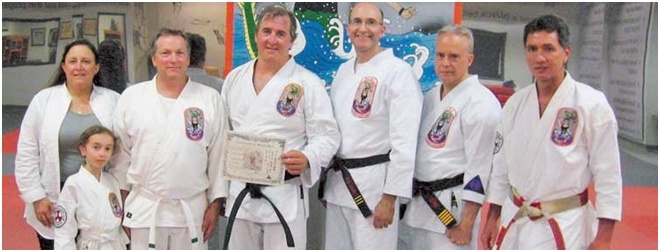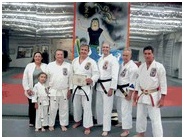
It's a mental game
There's more to karate than meets the untrained eye. It's a challenge for the mind, says Karate Master Michael Schaefer.
A.J. Hakim, Grosse Pointe News

September 27, 2012
Karate, Master Michael Schaefer said, is 90 percent mental; 10 percent physical.
It's a philosophy the seventh degree black belt and sensei for the
Grosse Pointe Karate Club stresses to students weekly during
Tuesday and Thursday classes at Kerby Elementary School.

At Dan Doyle’s black belt testing Friday, June 29, are, from left, Kim Karowitcz, Darby Fleig,
David Fleig, Dan Doyle, Rob Gamble, Dean Shunk and Michael Schaefer. photo by Michael Schaefer.
|

With trophies from July’s Grand Nationals Tournament in Orlando, Fla., are, from left,
Brendan Hess, George Hess, Natalie Schaefer, Vincent Radziecki, Craig Balow, Thomas Tomko,
Brian Fennell, Dean Shunk and Michael Schaefer. photo by Michael Schaefer.
|
"Every movement you do is preceded by a thought," said Schaefer, whose club, in partnership with the
Grosse Pointe Neighborhood Club, is a dojo in the Karate International Association of Isshinryu,
a style of Okinawan karate founded in 1956 by Tatsuo Shimabuku. The Okinawan style utilizes a
system of katas (formal practice methods) and kumite (sparring) techniques.
"There's an order to every single thing you do," Schaefer continued. "While it may look — from the
outside what you may see is only 10 percent of what that person is actually doing because
they're thinking about balance-acceleration, blocking. There's a lot more to it than what you
would think just by looking at it from the outside. It's a lot more challenging."
The challenge lies in the demand for a strict focus of body and mind — the physical and
mental — and commitment to training. It takes a minimum three-and-a-half to four years,
training at least three days a week, before a student's even considered for a black belt,
Schaefer said. At which point, the student must complete a written, oral and performance-based
test, demonstrating confidence in physical ability, speed, balance and power, as well as
sound knowledge of Isshinryu history, Okinawan terminology and fundamental principles of
Isshinryu karate.
And that's only the beginning, the new beginning, as the first-degree black belt's name,
Sho Dan, suggests. Training continues through to a tenth-degree black belt, or Ju Dan.
Though, achieving Ju Dan status means committing decades to the craft, as the required
training time between first- and second-degree black belts is two years, between second
and third is three and so on through 10.
"It's a long process," said Schaefer, who started practicing Isshinryu under sensei
Grand Master Willie Adams in 1982, of whom he remains a student.
In June, the Grosse Pointe Karate Club celebrated student Dan Doyle's first-degree black
belt achievement. Doyle is the first black belt recipient from Schaefer's recent
partnership with the Neighborhood Club, which he started about five years ago.
A group of students also performed at the KIAI's annual Grand Nationals Tournament
in Orlando, Fla., in July.
"What we're looking for when people join the class is somebody, people who have the
intention to do this for the rest of their lives," Schaefer said. "It's something you
can do your entire life. Your learning never stops. Only you stop."
Schaefer teaches classes three days a week, Tuesdays and Thursdays at both Kerby and
advanced class Saturdays at Parcells Middle School. Registration for both is through
the Neighborhood Club.
|








